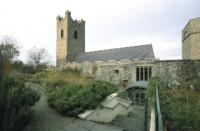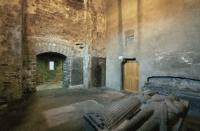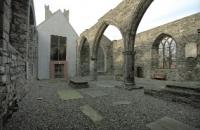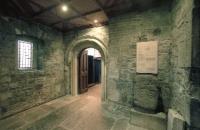Museum eye: St Audoen’s Church High Street, Dublin 8 staudoenschurch@opw.ie. +353 1(0) 677 0088 26 April–24 Oct., 9.30am–5.30pm by Tony Canavan
Published in Issue 3 (May/June 2012), Medieval History (pre-1500), Reviews, Volume 20
The entrance to the visitor centre, which used to be St Anne’s Chapel, built onto the original church in the Middle Ages.
Of all the properties under the control of the Office of Public Works, St Audoen’s Church must be the most unusual, in remaining a parish church where services are still held, just as they have been for over 800 years. Not far from the much grander Christ Church Cathedral, St Audoen’s is perhaps just as historically significant.The present visitor centre was originally St Anne’s Chapel, built onto the original church in the Middle Ages. Like the Portlester Chapel on the other side of St Audoen’s, it fell into disuse by the late nineteenth century and had its roof removed. By restoring a roof to St Anne’s, a modern yet historic visitor centre was created. As soon as you get in the door you are greeted by the cobbled stones of an early medieval lane that once ran down the side of the church—the only such lane uncovered in Ireland.

The elaborate tomb of Lord Portlester and his wife.
The visitor centre is on two levels, with the ground floor dedicated to the history of the church, which was founded in the twelfth century by Dubliners who disliked the Augustinian control of Christ Church. In the following centuries changes were made and additions, like the two chapels, built on. Even as late as the nineteenth century some extension was made, but the core of the medieval building remains intact and recognisable. In the display cases downstairs are models of the church at different eras, and examples of items found when archaeological excavations were carried out in the 1990s. These include tiles, clay pipes and other finds. After the Reformation St Audoen’s belonged to the Church of Ireland and its congregation played a prominent role in the city’s affairs. Some of them were people of power and influence, as is shown by the impressive array of church silver donated over the years.

The unroofed Portlester Chapel contains original architectural features and houses tombstones taken from a nearby graveyard when it was taken over for other purposes.
Probably the most important members of the congregation were the city’s guilds. These were established in the Middle Ages as support organisations for the various trades and crafts that constituted the city’s economy. Upstairs is a small but interesting exhibition on the guilds and their activities inside and outside the church. St Anne’s Chapel was built for them and at one time had numerous altars so that priests could offer Masses for the souls of departed masons, hosiers, silversmiths, candle-makers, tanners, etc.The main point of interest, however, has to be the actual building. St Anne’s Chapel and its surviving medieval features are well explained but pale beside St Audoen’s Church itself. You get to this through a door in the chapel wall. You will be struck immediately by the huge, elaborate alabaster memorial to the Sparke and Duff families from the Tudor period. This features life-sized statues of members of the family at prayer, surrounded by symbols of their wealth and reminders of death. Opposite this is an impressive organ still used to play music for Sunday services.The pews date from the nineteenth century and the walls are covered in plaques commemorating departed members of the congregation; Dubliners will recognise among them some of the city’s most prominent families from the past. At the other end of the nave is a baptismal font in a Romanesque style believed to date from 1190. Don’t forget to look down, for the floor is paved in part with tombstones from the eighteenth and nineteenth centuries.

A porch was built on to protect the original Romanesque doorway (centre). Note the ‘lucky stone’ to the right.
(All images: Photo Unit, National Monuments Service)
The door beyond the font takes you to a porch built in part to protect the Romanesque arch over the original doorway into the church. As well as more examples of patterned medieval tiles, the porch also contains Dublin’s ‘lucky stone’. A tombstone from the ninth century, it is believed to have marked the grave of a saint. There are many legends and superstitions attached to the stone, and rubbing it is supposed to bring good luck.Beyond this is the bell-tower housing the church’s six bells, some of which date from the fifteenth century. You can’t climb up the tower but can hardly avoid the elaborate tomb of Lord Portlester and his wife. He is depicted in a life-sized effigy as a twelfth-century knight, and his wife as a lady of the same period. Nearby is another tomb effigy, said to be of a bishop of Kildare. This is in a very bad state as it has been deliberately defaced. As with so much else, Oliver Cromwell—or at least his iconoclastic followers—is blamed for the vandalism.After this you can go outside to the unroofed Portlester Chapel. Named after the aforementioned lord, it contains original architectural features and is used to house tombstones removed from a nearby graveyard when it was taken over for other purposes. Although weather-worn, you can still read many of the historic inscriptions commemorating the dear departed.It would be easy to miss it from the street and it can be overshadowed by its grander neighbour, but there is a wealth of history in St Audoen’s Church. The visitor centre has a good exhibition and places its history in context, but the original medieval building and the other architectural features that survive are what make the visit worthwhile. They tell their own story and give you much to think about. And what other visitor attraction boasts a stone that can bring you good luck? HI
















